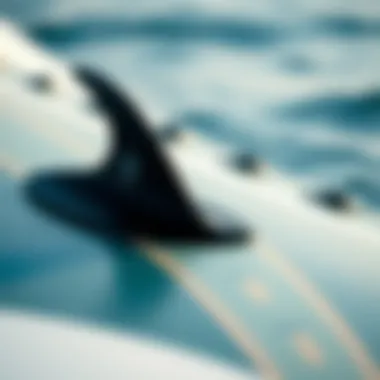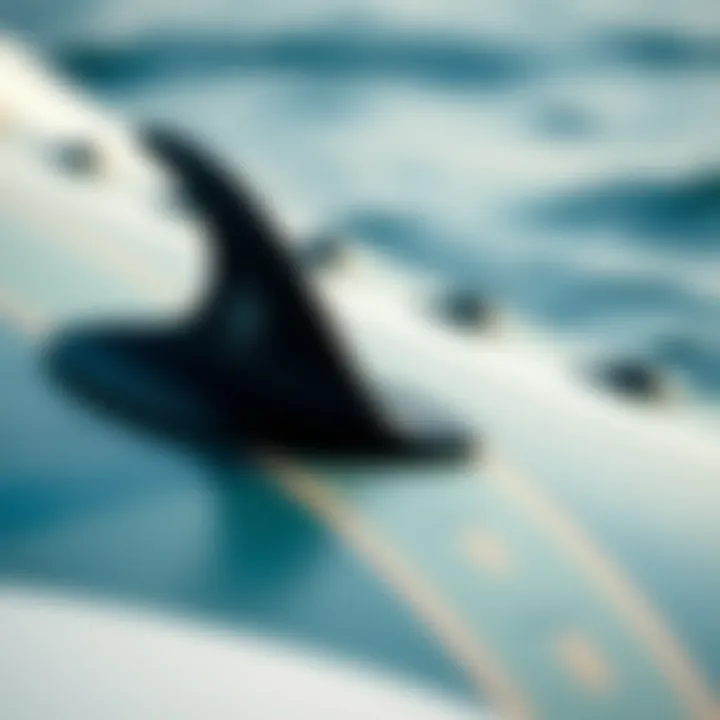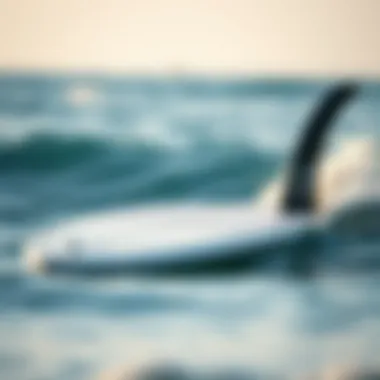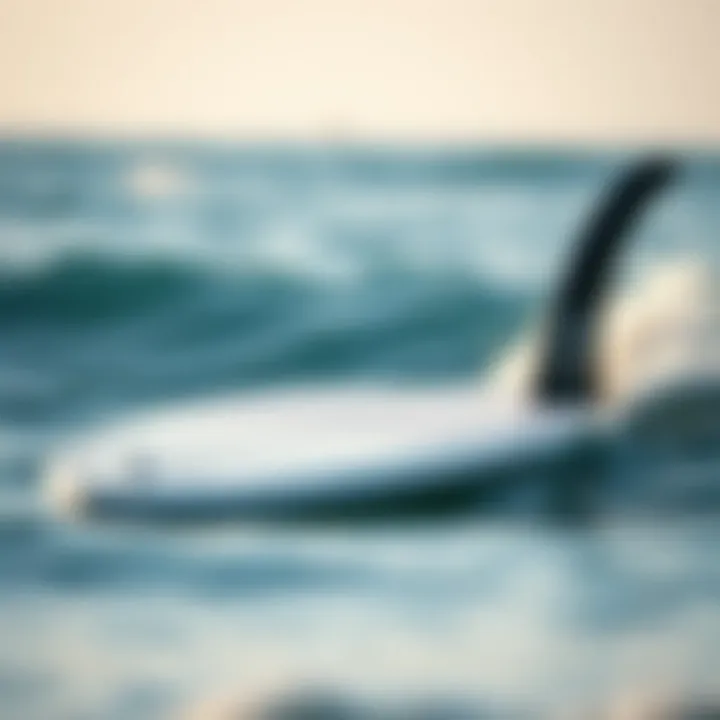Hydrofoil Surfboards: An In-Depth Analysis


Intro
Hydrofoil surfboards have taken the water sports world by storm, offering a unique riding experience that sets them apart from traditional surfboards. With a hydrofoil submerged beneath the board, surfers can glide above the water’s surface, creating an almost weightless sensation that many find exhilarating. This article aims to break down the design, functionality, advantages, and cultural implications of hydrofoil surfboards, carving out a comprehensive space for everyone from beginners to seasoned pros in the realm of hydrofoiling.
To genuinely understand hydrofoil surfboards, one must appreciate the mechanics at play. A hydrofoil consists of a mast, wings, and a fuselage, which work in unison to lift the rider above the waves with minimal drag. While the principles of physics underpin this technology are well-established, the artistry in design varies widely across different brands and models.
In this exploration, we will delve into several key themes including gear insights, riding techniques, safety practices, and the broader impact of hydrofoiling on surfing culture. With a careful analysis of each section, readers will gain clarity and knowledge to navigate the waters of this innovative sport effectively.
Whether you are just getting your feet wet or are fully immersed in the hydrofoiling scene, this resource is tailored to enrich your understanding and engagement with hydrofoil surfboards.
Intro to Hydrofoil Surfboards
As we embark on this journey through the world of hydrofoil surfboards, it's crucial to grasp what makes these innovative boards not just a trend, but a shift in water sports dynamics. Hydrofoil surfboards have gained traction for their unique design and performance capabilities, which set them apart from traditional surfboards. For enthusiasts and professionals alike—whether kiteboarders, instructors, or weekend adventurers—the exploration of hydrofoils offers insights into a sport that marries performance with an exhilarating sense of freedom.
The essence of hydrofoiling lies in its ability to elevate the rider above the water surface, hence minimizing drag and enhancing speed. This transformation has opened doors for surfers searching for new challenges and experiences on the water. Well-informed decisions regarding hydrofoil surfboards can substantially elevate one’s performance, making this topic not just relevant, but imperative for anyone with an enthusiasm for water sports.
Definition and Basic Concept
Understanding hydrofoil surfboards begins with the fundamental definition: they are boards equipped with hydrofoils—wings beneath the water that utilize hydrodynamic principles to lift the board above the surface. When the board gains sufficient speed, the hydrofoil generates lift, allowing the rider to glide above the water while reducing surface friction. This unique lift-drag ratio is what makes hydrofoiling so appealing.
The concept is not merely about speed; it provides a distinctive type of riding sensation that many find addictive. For many, hydrofoils represent a new frontier in surfing culture, combining elements of surfing and kiting into a novel practice that defies conventional limitations.
Historical Development of Hydrofoils
The journey of hydrofoils dates back to the early 1900s, with inventors like Gustave Eiffel playing a role in their initial design. His work established the foundational principles that would eventually shape modern hydrofoiling. Yet, it wasn't until the late 20th century that hydrofoil technologies found their way into recreational surfing.
Early experiments were more about crossing the realm of innovation in sailing and racing competitions. However, the yarn took a significant turn when enthusiasts began to craft custom boards. In the past few decades, technological advancements have given birth to hydrofoil surfboards as we know them today. This evolution saw designers focusing on materials and shapes that enhance maneuverability and performance.
Today, hydrofoils are crafted with a variety of materials like carbon fiber and aluminum, allowing for lighter weight and effective performance in different water conditions. Brands like Lift Foils, GoFoil, and Slingshot have paved the way with cutting-edge technology, evolving the sport into a mainstream phenomenon.
Mechanics of Hydrofoiling
Understanding the mechanics of hydrofoiling is akin to dissecting the lifeblood of this innovative water sport. Grasping how these boards operate fundamentally affects how enthusiasts approach their riding experience. Hydrofoiling might appear complicated at first glance, but it’s rooted in several fascinating physical principles that can dramatically enhance performance and the overall thrill of the ride.
How Hydrofoils Work
At its core, a hydrofoil comprises a wing-like structure that is submerged underwater. When a rider maneuvers the surfboard forward, water flows over the foil's surface. Thanks to the unique shape of the foil, a pressure difference is created between the top and bottom surfaces. This difference generates lift, which elevates the board above the water's surface, reducing drag significantly.
Think of it like this: when you ride a traditional surfboard, you're constantly battling wave resistance. In contrast, once you are up on the hydrofoil, it’s like soaring through the air—effortless and fast. The sensation resembles that of flying; as the board lifts, a newfound freedom emerges, where one glides over the water with minimal effort. The thrill lies not just in the speed but in the ability to glide smoothly over choppy waters that would typically throw a rider off balance.
Furthermore, the angle of the hydrofoil plays an essential role. Adjusting it can modify the lift, allowing for more control over your ride. For instance, angling the foil upward generates more lift, while a downward angle minimizes lift but enhances stability. It’s a fine balance, often requiring waves of practice to master.
Lift and Drag: The Physics Behind Hydrofoils
When discussing hydrofoils, the terms lift and drag surface repeatedly.
- Lift: Represents the upward force generated by the foil's shape as it moves through water. Increased lift allows the board to rise higher, creating a less turbulent riding experience. In simple terms, the stronger the lift, the more the board elevates above the motion of the water beneath it.
- Drag: This is the opposing force that can slow down your ride. Reducing drag is crucial for maximizing speed. Hydrofoils are designed specifically to minimize drag so that you can optimize glide and speed.
Interestingly, careful attention to other factors such as board size, weight distribution, and riding technique also affect the balance of lift and drag. A rider who maintains an optimum body position can enhance lift while reducing drag, making adjustments smoother.
Understanding these physics helps in refining techniques. Knowledge of how lift and drag work in tandem can equip riders with skills to tackle not just waves, but any water condition thrown their way.
The physics of hydrofoiling, with its complex interplay of lift and drag, is the backbone of what makes this sport both challenging and exhilarating.
Types of Hydrofoil Surfboards
Understanding the various types of hydrofoil surfboards is essential for anyone looking to dive into this exhilarating sport. Each type of surfboard is designed with specific intentions, catering to a range of abilities and preferences. Knowing the differences can enhance not only your riding experience but also your performance in varied conditions. Here, we explore the different categories of hydrofoil surfboards, paying close attention to design variances and the unique features that distinguish them from one another.
Foil Design Variations
The design of hydrofoils can significantly affect speed, stability, and maneuverability. These boards are typically categorized based on their foil design, which often includes the shape and size of the wing.
- Wing Shape: The shape of the wing plays a crucial role in how the board responds to water.
- Foil Size: The size of the foil influences the lift and overall stability. A larger foil offers more lift, making it suitable for slower speeds or lighter riders. Conversely, a smaller foil can be more controllable at high speeds.
- Material Choices: Construction materials can also vary. Some foils are crafted from aluminum due to its light weight and durability, while others utilize carbon fiber for enhanced performance and reduced weight. Each material has its own set of advantages and drawbacks, which can affect not only performance but also the overall cost of the board.


- High Aspect Ratio Wings: These are slim and long. They provide good performance at high speeds and are generally more efficient, allowing for more glide.
- Low Aspect Ratio Wings: These wings are shorter and wider. They provide better lift at lower speeds, making them easier to ride, especially for beginners.
These design variations affect how the rider interacts with waves and can make a significant difference in both comfort and performance.
Differences Between Surf Foils and Kite Foils
While hydrofoil surfboards generally serve the same fundamental purpose, they do diverge significantly between surf foils and kite foils. Understanding these distinctions is vital for selecting the right gear for your specific needs.
- Purpose and Design:
- Stability:
- Rider Input:
- Surf foils are designed to be used in ocean waves. They often have a larger and more buoyant wing to accommodate the nature of wave riding. These foils are built to create lift as soon as the board begins to move, allowing the rider to glide over the surface of the water with minimal resistance.
- Kite foils, conversely, are adapted for use with a kite. Their design focuses on performance in various wind conditions, making them more streamlined to catch gusts and facilitate higher speeds.
- Surf foils typically provide more stability when ridden in the waves, hence focusing on smooth transitions and extended rides. They’re engineered for the dynamic movement of waves, requiring specific adjustments in design.
- Kite foils prioritize speed and agility, offering a different sensation of control and responsiveness that cater to the fast-paced nature of kiteboarding.
- The way a rider operates these boards also differs. Surf foils demand continuous adjustment and weight shifting to maintain balance and optimize lift during wave riding.
- Kite foils feature greater adaptability to changes in wind, requiring a different set of skills and awareness from the rider, often needing them to engage with the kite’s power more actively.
In summation, choosing between surf foils and kite foils hinges on not just personal preference but also intended use and riding style. Grasping these distinctions can indeed enrich your experience and enhance performance, making your time on the water all the more enjoyable.
Benefits of Using Hydrofoil Surfboards
Hydrofoil surfboards have revolutionized the way riders experience the ocean. These innovative boards offer a range of advantages that set them apart from traditional surfboards. Understanding these benefits is essential for anyone looking to enhance their surfing experience. Here, we will explore how hydrofoil surfboards can elevate your performance and enjoyment on the water.
Speed and Gliding Capability
One of the most striking features of hydrofoil surfboards is their capacity for speed and smooth gliding. When a rider is on a hydrofoil, the board lifts above the water, significantly reducing drag. This lift allows for quicker acceleration and higher speeds compared to conventional surfboards.
Riders often describe the sensation of flying over the waves as liberating. This gliding effect minimizes the resistance typically felt from water, allowing for a seemingly weightless experience. For enthusiasts who are accustomed to paddling hard for speed, this change can be game-changing. A few elements contribute to this:
- Reduced Friction: With less surface area in contact with the water, there is less resistance overall.
- Streamlined Design: Hydrofoils are engineered to maximize water flow, keeping the rider above turbulence.
- Dynamic Lift: As riders shift their weight and adjust their stance, they can manipulate lift and speed effectively.
In the context of competition, this enhancement in speed can translate to better race times, particularly in wind conditions that are less than favorable. Riders can cover distances faster and with less energy expended.
Performance in Varied Conditions
Another notable benefit of hydrofoil surfboards lies in their versatility in different water conditions. Unlike traditional surfboards that are often dependent on specific wave types, hydrofoils excel in various settings. For travelers or adventurers who surf in diverse locales, this aspect can be particularly appealing.
Consider the following:
- Flat Water Performance: Hydrofoils can be ridden in relatively calm waters, where traditional boards may struggle to perform. Lakes, bays, or even rivers present fresh opportunities for enjoying the thrills of hydrofoiling.
- Wind Heights: Hydrofoil surfboards provide excellent stability and control even in choppy or gusty winds, allowing riders to focus on technique rather than being tossed around by the ocean’s whims.
- Broad Wave Range: Whether you're tackling small rollers or larger swells, hydrofoils adapt easily. The ability to ride effectively on smaller waves gives riders the chance to capitalize on conditions that many wouldn’t consider ideal.
A hydrofoil's adaptability not only expands the environments in which riders can surf but also enriches the overall experience by enabling them to explore new waters.
The unique design and functionality of hydrofoils lead to a remarkable fusion of speed and versatility, making them a compelling choice for Kitesurfers, instructors, and avid adventurers alike.
Choosing the Right Hydrofoil Surfboard
Choosing the right hydrofoil surfboard is a critical step for anyone looking to dive into this exhilarating water sport. Not only does the correct board enhance performance, but it can also significantly impact the learning curve. Each suction and dip in the water relies on selecting equipment that aligns with individual skill levels, desired experiences, and environmental conditions.
When navigating the choices available, a few specific elements should be at the forefront of your mind. Factors such as board length and width, foil size, and intended usage shape the surfing experience. Moreover, understanding your own proficiency level allows you to select a board that transitions smoothly through learning and mastery phases.
Key Factors to Consider
- Skill Level: Consider where you stand in your hydrofoiling journey. Beginners may want larger boards for stability, while more experienced surfers might prefer compact ones for agility.
- Board Size: The dimensions of the board can influence buoyancy and lift. A longer board offers more stability but may sacrifice some maneuverability. Conversely, shorter boards can facilitate sharper turns but require more control.
- Foil Size and Shape: The design of the foil matters a lot. Larger foils are better for low-speed lift, making them suitable for beginners, while smaller foils conduct increased speed — perfect for advanced riders looking for thrills.
- Riding Style: Identify how you want to ride. Are you after a laid-back, gliding experience, or are you in search of performing tricks and navigating waves? Specific models cater to particular styles, making this a key consideration.
- Budget: While premium boards can be a joy in the water, many viable options exist that cater to tight wallets without negligible performance.
Recommended Models for Different Experience Levels
Selecting models tailored to specific experience levels can further enhance your hydrating experience. Here are recommendations:
- Beginners: Look into the Naish Hover 2021 or Slingshot Freeride. These boards provide ample stability and durability, allowing newbies to get a grasp on the basics without fumbling.
- Intermediate Riders: Models like the Fanatic Sky and Moses 633 can help you progress. They strike a balance, assisting with transitions while allowing experimentation with more advanced maneuvers.
- Advanced Surfers: If you are saucy enough, consider the Lift Foils Carbon 2022 or the Gofoil Kai. These shapes can dance on water smoothly, providing an exhilarating experience that taps into your knowledge and skills.
Choosing wisely will not only deepen your appreciation for hydrofoiling but also leave you cruising comfortably atop the waves. Incorporating learned insights into your selection process will ensure that your introduction — or reintroduction — to hydrofoiling is nothing short of a delightful adventure. Let's take this learning into practice and elevate your skills in the pursuit of thrilling rides.
Techniques for Riding a Hydrofoil Surfboard
When it comes to mastering hydrofoil surfboards, understanding the techniques involved is imperative. This section digs deeper into the nuances of riding a hydrofoil, breaking down fundamental skills as well as advanced tricks that can set a rider apart from the crowd. The journey from novice to expert is not only thrilling but also reflects the evolving nature of water sports.


Fundamentals of Hydrofoiling
Riding a hydrofoil is a different beast compared to traditional surfing. Here are some basic fundamentals that are crucial for new riders:
- Body Positioning: It’s all about your stance. Keep your feet shoulder-width apart, knees slightly bent, and your weight centered over the board. Unlike a traditional surfboard, where you can lean back a bit, on a hydrofoil this can lead to instability, causing you to crash.
- Foil Setup: Understanding your hydrofoil setup is essential. A well-balanced foil will have its front wing positioned correctly, tailored to your size and skill level. Experimenting with the positioning can significantly impact performance.
- Speed and Momentum: Hydrofoils lift off the water at speed, so getting up to this speed is key. A good takeaway is to paddle hard to gain momentum before popping up. It’s a delicate balance between finesse and power.
- Control Techniques: Keep your hands relaxed on the handles and stay aware of your body's center of gravity. If you’re feeling too much lift, lean back slightly. Conversely, if you’re sinking, adjust your weight forward. The foil's response is immediate, requiring quick adjustments.
So in short,
- Start steady,
- Stand firm,
- Ride smart.
Getting these fundamentals right can result in an exhilarating ride where you truly feel the freedom of gliding above the water.
Advanced Maneuvers and Tricks
Once you’ve mastered the basics, it’s time to up your game. Advanced techniques can elevate your experience and impress your fellow riders.
- Turns and Carves: Achieving smooth turns requires the blend of speed and technique. Initiate a turn by shifting your weight toward the edge you want to turn. Lean into the turn and let the foil carve through the water. Practicing this will allow you to ride through waves more seamlessly.
- Jumping and Air Tricks: With enough speed, you can take off from a wave and add some aerial maneuvers to your repertoire. Approach a wave with sufficient speed, crouch down, and then explode upwards. Timing is crucial here; a good jump comes from the right moment.
- Riding Swells: Mastering how to ride swells involves reading the water ahead. Rather than simply following it, position yourself to catch the swell and glide smoothly. This not only enhances your technique but also makes riding longer and more enjoyable.
- Sliding Tricks: These can impress onlookers and show off your skill. While riding, shift your weight to one side and allow your hydrofoil to 'break' loose to slide or pivot. However, ensure you have controlled speed to avoid falling.
To sum it up, techniques in hydrofoiling are about finesse, balance, and a dash of daring.
"In mastering the art of hydrofoiling, riders learn to become one with the water, converting every wave into a canvas for expression."
Riders who take the time to practice these techniques will not only improve their performance but also enrich their overall experience on the water.
Safety Considerations
When it comes to hydrofoiling, prioritizing safety cannot be overstated. Engaging in this thrilling sport requires an awareness of the potential risks involved. Overall, knowing how to mitigate these risks enhances the enjoyment of hydrofoiling, promoting a safer environment for everyone out on the water.
Understanding Risks Associated with Hydrofoiling
Hydrofoiling, while exhilarating, does not come without its own set of dangers. Riders must navigate various hazards, ranging from equipment failure to environmental factors. One significant risk is collisions; since hydrofoil boards elevate above the water surface, a miscalculation can lead to dangerous impacts with other surfers or obstacles. Additionally, the speed achieved while hydrofoiling can be alarming, making it easy to lose control or misjudge distance.
Another element to consider is the physical strain on the body. Maintaining balance and coordination while navigating waves can lead to fatigue, which might increase the likelihood of accidents. Furthermore, the sport demands awareness of changing ocean conditions, such as currents and tides. Lull in attention may result in a harsh tumble, notably if waves catch a rider off guard. Awareness and response abilities are paramount.
"A helmet is not just an accessory; it's a necessity in hydrofoiling. Protect your noggin and ride smart."
Safety Gear and Precautions
Equipping oneself properly is critical when hydrofoiling. Safety gear is designed to protect riders from the inherent risks associated with the sport. Here’s a rundown of essential items:
- Helmet - Always wear a certified helmet. Given the potential for falls and collisions, protecting the head is paramount.
- Impact Vest - An impact vest provides cushion and flotation. It can also help stabilize your body while you ride.
- Leash - A reliable leash can prevent a hydrofoil board from drifting away after a wipeout, and also stop it from becoming a hazard to others on the water.
- Footstraps - Straps help secure your feet to the board, which can improve balance and reduce the risk of losing control.
- Wetsuit - Depending on the water temperature, a wetsuit can keep you warm during long sessions and provide an extra layer of protection.
When planning a hydrofoil session, it’s wise to check environmental conditions. Be aware of local regulations and advisories, and minimize risk by learning about the area where you will be riding. Hydrofoiling in groups can also provide an extra layer of safety; having fellow enthusiasts around can assist in monitoring risks and responding to emergencies.
In essence, being mindful of potential dangers and investing in quality safety gear not only secures individual well-being but also fosters a culture of responsibility within the hydrofoiling community.
Environmental Impact of Hydrofoiling
The conversation around surfboards usually centers on performance and fun, but there’s an increasingly important aspect that deserves attention: the environmental impact of hydrofoiling. As adventure sports become more popular, their effects on our ecosystems are coming under scrutiny. This section aims to dissect the significance of hydrofoiling in this context, weighing the sustainability efforts in construction against the effects on marine habitats.
Sustainability in Hydrofoil Construction
When we discuss the sustainable production of hydrofoil surfboards, it’s crucial to consider the materials used. Traditional surfboards have often relied on polyurethane foam and fiberglass, materials that can be quite damaging both during production and after disposal. Thankfully, innovation in the hydrofoiling community has prompted a shift towards more environmentally friendly alternatives.
Many manufacturers are now experimenting with eco-conscious materials such as recycled plastics, bio-resins, and sustainably sourced woods. For instance, some brands utilize bamboo or cork for their boards, ensuring that not only do these materials perform well, but they also leave a smaller footprint. The choice of epoxy resins in some boards offers a lighter option while providing greater durability, which translates into fewer resources spent on replacements.
Additionally, eco-friendly manufacturing processes are gaining traction. These include low-waste production techniques and energy-efficient facilities that reduce emissions during the construction phase. Investing in such technologies can significantly lower the overall environmental impact of surfboard manufacturing. As customers become more aware of these factors, companies that prioritize sustainability see their reputations grow—adventurers are more likely to support brands that care for the planet.
Effects on Marine Life and Ecosystems
While hydrofoils present several advancements in surfing, they also pose unique challenges to marine ecosystems. The speed and agility of these boards allow riders to explore more remote areas, sometimes encroaching on habitats that may be vulnerable to disturbance.
Hydrofoiling requires navigating areas with greater biodiversity—the very places that are home to delicate marine life such as coral reefs and nesting grounds for various fish species. The physical presence of surfers in these zones can inadvertently lead to habitat degradation. Careless riding can uproot aquatic vegetation and disturb breeding fish, impacting local populations.
On the bright side, seasoned riders are often the first to advocate for marine conservation. Many in the hydrofoiling community actively participate in environmental initiatives. Organizations are forming to promote awareness about responsible riding practices that respect marine habitats. Riders are encouraged to maintain a distance from sensitive areas and avoid disturbing wildlife.


Furthermore, technology is being developed to mitigate the impact of hydrofoiling on marine life. For example, some boards have sonar systems that help riders navigate deeper waters while avoiding shallow reefs. This aspect of technological innovation aligns closely with a broader goal—creating a water-sport culture that celebrates both thrill and conservation.
"The future of hydrofoiling must include a commitment to preserving marine ecosystems, creating a harmonious balance between adventure and environmental stewardship."
Future of Hydrofoil Surfboarding
The future of hydrofoil surfboarding holds a realm of possibilities that promises to reshape the water sport landscape. As an innovative approach to traditional surfing, hydrofoiling is carving its niche into the hearts of enthusiasts and casual surfers alike. So, what can we expect in the coming years? The elements surrounding this evolution are multifaceted, weaving together advancements in technology, cultural shifts, and the eager exploration of new surfing techniques.
Technological Innovations on the Horizon
At the forefront of the future are technological innovations aimed at improving performance and accessibility. Manufacturers are pouring research and resources into developing lighter materials and advanced designs that enhance the gliding experience. For instance:
- Carbon Fiber Construction: Builders are increasingly using carbon fiber to create lightweight but incredibly strong boards. This affects performance positively, making it easier for riders to achieve lift and stability.
- Smart Hydrofoil Systems: Imagine a hydrofoil with built-in sensors that can adjust its shape based on the surf environment. This is not just science fiction; prototypes are being tested, promising riders an unparalleled level of adaptability.
- Electric Hydrofoils: These boards are already making waves in the market, allowing non-surfers to glide over water. Battery advancements mean they’re becoming more reliable and user-friendly, thus broadening the market appeal.
These innovations are expected to enhance safety and ease of use, making hydrofoiling more approachable for beginners while still thrilling for seasoned pros.
Emerging Trends in Water Sports
With the rise of hydrofoil surfboards, several trends have begun to surface, reflecting changing attitudes towards water sports. As more surfers embrace hydrofoiling, some trends to watch include:
- Increased Focus on Sustainability: Environmental consciousness is no longer a selling point; it's becoming a necessity. Companies are starting to prioritize sustainable manufacturing practices, such as using reclaimed materials in hydrofoil construction. This aligns with a broader trend of eco-awareness in water sports.
- Cross-training with Water Sports: Surfing, kiteboarding, and windsurfing are merging. Hydrofoils provide a new way for athletes to experiment with cross-training. This not only builds community but deepens the understanding of different water dynamics.
- Performance-based Competitive Events: Given the unique thrill of hydrofoiling, competitions geared specifically toward this sport will likely rise in popularity. Events that marry traditional surfing with hydrofoiling skills will provide an exciting arena for showcasing talent.
"The wave of the future is about melding technology with tradition, creating a rich tapestry of experiences for all water sport lovers."
Cultural Impact of Hydrofoiling
The advent of hydrofoil surfboards is not merely a technical advancement; it has ushered in a cultural shift within the surfing community. This transformation resonates in both competitive settings and popular media, shaping how enthusiasts perceive water sports. Analyzing this cultural significance reveals intricate layers of influence, demonstrating how hydrofoiling reverberates through various aspects of modern society.
Hydrofoiling in Competitive Surf Events
Hydrofoiling has firmly planted itself in the competitive surfing arena as a distinct discipline that binds traditional surfing with innovation. Events dedicated to hydrofoiling have been cropping up, highlighting the unique skill set required to master these boards. Competitors ride powerful waves while elevated above the water, experiencing a different kind of thrill that traditional surfing does not deliver.
During contests, riders showcase a variety of techniques that elevate their performance to breathtaking heights—literally. Through practiced maneuvers, athletes carve effortlessly while catching speed like a bullet. The desire to optimize performance has led to enhanced training regimens and specialized equipment, underscoring a commitment to the sport's evolution.
Teams and communities are also forming around competitive hydrofoiling, fostering camaraderie and support among riders. These events help in normalizing hydrofoiling as a serious contender in the surfing hierarchy. Moreover, showcasing hydrofoiling at high-profile competitions, like the World Surf League, pushes it into the mainstream, enticing spectators and potential new practitioners alike.
"Hydrofoiling offers a unique thrill that traditional surfing can't match, urging riders to explore new heights—both in performance and perception."
Inspiration from Hydrofoiling in Art and Media
The influence of hydrofoiling stretches beyond the shores and into artistic realms, inspiring a host of media representations that capture the essence of this innovative sport. Artists, filmmakers, and photographers are gravitating toward hydrofoiling as a subject ripe for exploration. The surreal visuals created by a surfer cutting above the water, with the sun shimmering below, offer an aesthetic that is both striking and profound.
Films and documentaries focusing on hydrofoil surfing are beginning to emerge, showcasing spectacular gliding sequences while diving deeper into the rush that riders experience. These visual narratives not only highlight individual stories of triumph but also document the burgeoning culture around this unique form of surfing.
Life on social media has amplified the visibility of hydrofoiling, too. Platforms like Instagram and TikTok see an influx of videos where riders demonstrate their skills, creating viral content that often transcends the surfing community. This online presence attracts attention from those who may never have considered hydrofoiling before, potentially leading to growth in the sport as they seek to join in on the excitement.
In rigorously capturing hydrofoiling through art and media, society grapples with its identity as it navigates the blend of tradition and innovation, art and athleticism. The interplay of these elements showcases hydrofoiling not just as a sport but as a cultural phenomenon, encapsulating the spirit of adventure that defines water sports today.
Culmination
In wrapping up this comprehensive analysis of hydrofoil surfboards, we come to appreciate the multifaceted nature of this sport-changing innovation. Hydrofoiling is not just a fleeting trend but an evolutionary leap that marries technology with the thrill of riding waves. The insights we have unpacked provide a clear view of how these unique boards operate, the nuances of their design, and the numerous benefits they possess in user experience.
Summarizing the Hydrofoil Experience
The journey through the world of hydrofoil surfboarding reveals a rich tapestry of experiences. Hydrofoil surfboards offer riders an ability to glide effortlessly over water surfaces, thanks to the lift generated by the foil below the board. Riders experience a newfound sense of speed and smoothness, particularly during choppy conditions where traditional surfboards might struggle. This unique experience can be summarized as follows:
- Elevated Thrill: The sensation of being above water adds a thrilling dimension to the ride, beckoning an exploration for both beginners and seasoned riders alike.
- Performance Versatility: Hydrofoil surfboards adapt well to various conditions and crafts like kiteboarding and paddleboarding, amplifying the transition between water sports.
- Innovative Design: With different designs catering to various skill levels, hydrofoil surfboards serve a diverse audience.
Ultimately, the hydrofoil experience is about embracing the unknown and pushing the boundaries of what is possible on water. As you become more accustomed to handling the board, the rewards of skilled manuevering become clear, often leaving riders hooked.
Final Thoughts on Hydrofoil Surfboards
While hydrofoils may appear complex at first glance, the underlying principles are quite straightforward once broken down. It's a dance between lift and drag, executed with grace and finesse. Understanding this balance can lead to an enriching, highly rewarding experience, both on the water and off.
The distinct advantages over traditional boards—like enhanced speed and ability to ride in minimal wave conditions—paint a promising future for hydrofoils in the surfing community. With ongoing innovations on the horizon, such as better materials for durability and eco-friendly designs, hydrofoil surfboards are poised to redefine what it means to surf in the coming years.
Resources for Further Reading
Embracing the hydrofoil is embracing the future of surfing, and that bodes well for all key players in the sport.















